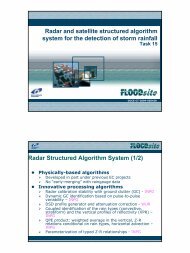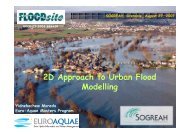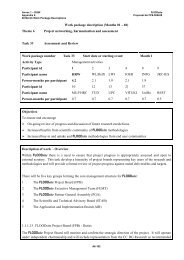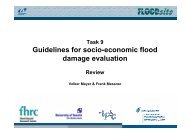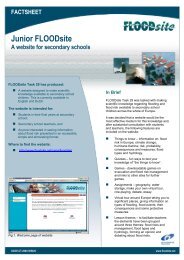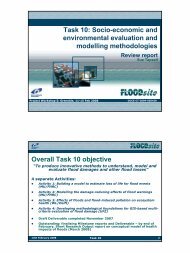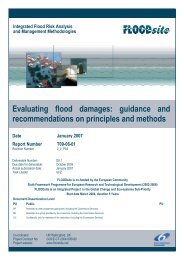Evacuation and traffic management (full report) - FLOODsite
Evacuation and traffic management (full report) - FLOODsite
Evacuation and traffic management (full report) - FLOODsite
Create successful ePaper yourself
Turn your PDF publications into a flip-book with our unique Google optimized e-Paper software.
Task 17 <strong>Evacuation</strong> D17-1<br />
Contract No:GOCE-CT-2004-505420<br />
– A marshalling area for assembling vehicles <strong>and</strong> equipment;<br />
– A body holding area that is under cover <strong>and</strong> protected from public view;<br />
– A media liaison point.<br />
(Source: HM Government 2005b)<br />
2.2.6 <strong>Evacuation</strong> planning<br />
It is important to note that in the UK evacuation can only be advised not ordered. The possible need<br />
for evacuation of the public from the immediate vicinity may have to be considered at a very early<br />
stage. In some circumstances it may be necessary to advise the public on whether they should<br />
evacuate a given area or remain <strong>and</strong> shelter indoors.<br />
It is normally the police who recommend whether or not to evacuate <strong>and</strong> define the area to be<br />
evacuated. Their recommendation will take account of advice from other agencies. The Fire <strong>and</strong><br />
Rescue Service will inform them about risks associated with fire, contamination <strong>and</strong> other hazards.<br />
Ambulance services <strong>and</strong> local authorities can advise on problems associated with moving people who<br />
are frail, disabled or at risk for any other reason. Local authorities will also be able to identify<br />
individuals or groups of individuals that may need particular support. Local authorities can also<br />
advise on the location of pre-designated rest centres <strong>and</strong> on other possible places of shelter within the<br />
area (HM Government 2005a, 2005b).<br />
The police can only recommend evacuation <strong>and</strong> have no power (except within the inner cordon in<br />
response to a terrorist incident) to require responsible adults to leave their homes. Past experience has<br />
shown that people with domestic pets may be unwilling to leave their homes unless arrangements<br />
include them.<br />
In deciding whether to evacuate or not, it is necessary to assess whether bringing people outdoors may<br />
put them at greater risk than leaving them where they are to shelter indoors. This is particularly<br />
important where flood water levels are likely to rise quickly.<br />
When planning for contingencies, building occupiers should seek professional advice on whether there<br />
are areas in the building where people can shelter safely. Such areas must be structurally robust <strong>and</strong><br />
should be equipped with telephones, first-aid facilities, adjacent toilet facilities <strong>and</strong> a water supply.<br />
There are particular problems in evacuating hospitals, prisons <strong>and</strong> nursing homes, <strong>and</strong> in evacuating<br />
those individuals who are at home, but are frail or vulnerable. Large scale evacuation is a last resort<br />
owing to the length of time it takes to complete <strong>and</strong> the risks the public may be exposed to as a<br />
consequence of being evacuated. Local planning should include arrangements to support people<br />
sheltering in their own homes where this is the safest option.<br />
However, when there is a decision to evacuate, evacuation assembly points should be set up near the<br />
affected area. If time permits, these should be signposted. People in the affected area should be<br />
advised to go to their nearest evacuation assembly point. People taking prescribed <strong>and</strong> other<br />
medications should be reminded to carry these with them, <strong>and</strong> particular attention needs to be paid to<br />
those with sensory impairment.<br />
Bearing in mind that evacuation may be at different times of day or night <strong>and</strong> from locations as<br />
different as homes, industrial complexes, shopping malls, venues, ports or airports, various methods<br />
can be used for warning <strong>and</strong> informing the public: loudhailers, tannoys, mobile public address<br />
systems, radio or TV announcements, works sirens, display screens, scoreboards <strong>and</strong> monitors, or<br />
various combinations of these methods (HM Government 2005a, 2005b).<br />
T17_07_02_<strong>Evacuation</strong>_<strong>and</strong>_<strong>traffic</strong>_<strong>management</strong>_D17_1_V4_4_P01.doc 19 03 2008<br />
18




